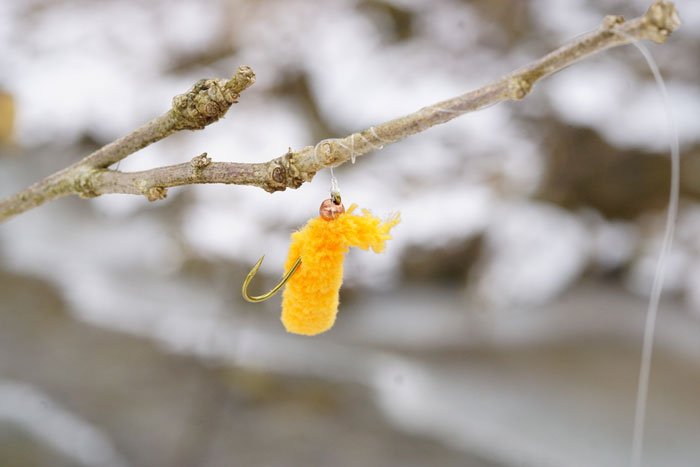Avoid “The Hanging Tree” - Leave No Fly Behind
Photo by George Daniel
Written by: George Daniel, author of Dynamic Nymphing
Anyone familiar with The Hunger Games trilogy will recall a scene in the movie when the heroine sings the lyrics to a song titled, “The Hanging Tree.” This morbid tune is about death, but for some reason it made me think about several recent trips on a nearby trout stream.
Recently I’ve been amazed by the number of flies and rigs that anglers have left hanging on streamside trees and bushes. On one stretch of water that I frequent on a weekly basis, I’ll usually see a number of hanging patterns, so I wade across the stream and cut them free. The flies are in great shape since they’ve only been there for less than seven days (since the last time I waded across and cut them from the same spot). Sure enough, there will be in the same spots the time I show up. And it’s easy to wade across and retrieve the pattern, so I can’t understand why these patterns are left to hang.
I have heard numerous fly fishers criticize spin and bait anglers for throwing trash on the ground as well as leaving large bobbers and monofilament in the trees. This garbage becomes an eye sore for the next angler traveling through, and there’s always the possibility of a bird accidentally eating the bait or lure hanging on the tree. In that case, the tree become a literal “hanging tree,” where bird corpses hang. In 2017, I cut down four dead swallows that mistook a hanging fly for live insect.
I’ve come to the realization that fly anglers are sometimes just as guilty (if not more so) as those who participate in other forms of fishing. The introduction of the Mop Fly, especially the larger and gaudier ones, has made this even more apparent. It’s easy to miss a Pheasant Tail Nymph or a small Elk-Hair Caddis dry fly that’s been broken off in a tree. These patterns are small and blend into the surroundings. The Fisherman’s Paradise section on Pennsylvania’s Spring Creek, is a perfect example of a highly pressured trout stream where, if you were to spend time looking close in the canopy surrounding the most popular sections, you would find dozens of small midge patterns hanging in the trees. However, replace every small, drab pattern for a brightly colored Mop Fly, and it would look like anglers were decorating for Christmas. Many of my favorite stream sections are now riddled with these gaudy patterns. In my opinion, this is no different than seeing empty beer cans or candy-bar wrappers on the ground. We are better than this. And let me make it clear, I’m not excusing myself for these eyesores and bird snares.
I make plenty of bad casts and stick flies in the trees with disturbing regularity. Often, I’ll decide to wait to wade across stream to retrieve the fly, so I can continue fishing the water without spooking the fish. Sometimes, however, I become so focused on fishing that I forget about the almost invisible midge pattern I left hanging. It’s easy to do with small patterns, but I can’t recall a time when I left a large brightly colored pattern in the tree. When I leave a Mop Fly in a tree, it’s always in view and reminds me not to forget it when moving to another section. The only reason I’ll leave a fly hanging in the tree is if it’s dangerous on not feasible for me to retrieve it. However, so many of the patterns I see hanging in trees are easy to retrieve.
Consider this a reminder for all anglers to think about the impact they leave for wildlife and other anglers. With more fly anglers fishing less public property, it’s important that we take the extra minute to do everything we can to retrieve our hanging flies, so the next angler is not exposed to our littering nor is a curious birds sent to its death. These occurrences are not 100% unavoidable, but we can do more to minimize our footprint.
One of my resolutions for 2018 is to leave no fly behind, so I don’t contribute to the hanging tree. I understand this goal is probably impossible, as there will be many occasions when my ill placed cast will not allow me to retrieve a fly (as when the fly ends up too high in the tree, where I can’t climb). However, if all anglers make a more conscious effort to leave no fly behind, we’ll allow the next passing angler to better enjoy his or her experience. And even better yet, we won’t be reminded of that morbid “Hanging Tree” song while bathing in our fly fishing bliss.
George Daniel operates Livin On The Fly, a guide service in State College, Pennsylvania. He is also the author of Strip-Set: Fly-Fishing Techniques, Tactics, & Patterns for Streamers, as well as Dynamic Nymphing.

